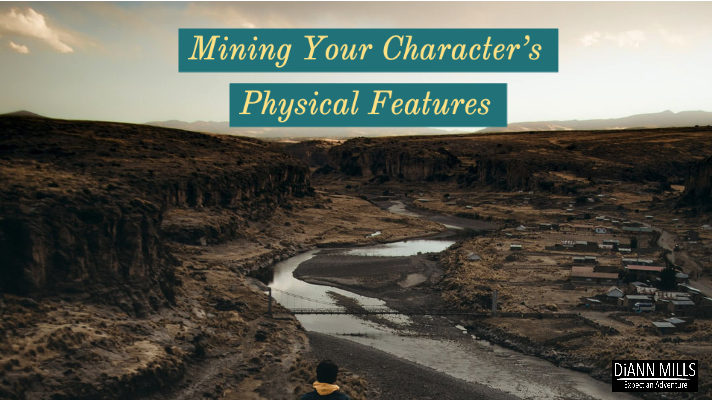by DiAnn Mills, @diannmills
Writers of all genres explore techniques to reveal their character’s inner traits. Observing the character’s behavior in action and dialogue shows the reader behavior patterns without telling. The writer is also able to create memorable scenes, endear the character to readers, and move along the plot.
But what about the character’s physical features? Can those details enhance critical points of motivation and address psychological issues? Specifically, how does a suspense writer approach the outer landscape of character? In our genre, the clock is ticking, no time to waste on techniques that other genres may require. Tension, uncertainty, and doubt are players that a reader expects.
Let’s take a look at a few basic physical traits that we assign our characters to find gems of motivation.
Age
A writer’s role in creating story requires characters who either have the skills and abilities needed for the task or are willing to attain them. Age is associated with the undertaking. But what if the character is younger than those who normally perform the job? What if the character is much older? How would the age deviation work against the case? How could age mask the identity of a protagonist or antagonist?
Height
Rarely is height an issue in solving or preventing a crime. A character can be short or tall, and the mention may or may not be shown in the story. But what if the character is dwarf or giant? The height or lack can’t be hidden to others in the story. How does height or lack of height affect a character psychologically? How can it be a hindrance or an advantage in a mystery or suspense novel?
Weight
Is the character large? Skinny as a fence post? How does that affect the confidence of a character who has a dangerous mission? Hard to work undercover when the character can’t squeeze through a door. Hard to be incognito as a superhero when the protagonist shops in the kid’s department. David Baldacci features a large hero, Amos Decker, in The Memory Man. The character is distinct and memorable, and his size merely adds to the exceptional characterization.
Right-handed or Left-handed
In western culture, a reader may or may not notice a character who uses his/her right or left hand. It may or may not be mentioned in the story. Contrast that with a story that takes place in a middle eastern country and hand protocol is critical. What obstacles will the character encounter? Will the character fumble in the mission because he/she is conscious about using the correct hand? How does the unlikely hero play into this scenario?
Ears
Ears can have an adverse effect on how characters view themselves. For girls, they simply let their hair grow to cover them. For guys, they have probably been ridiculed since childhood. Consider a girl who has huge ears. As a little girl, her mother didn’t want to style it, so she had the girl’s hair cut short. Imagine the teasing. As soon as the girl took control of her own hair, she let it grow. But what does she remember about the teasing? Is she still self-conscious? Shy? Can she perform her role in the story with those taunting voices in her head? Could she have been so scared that she becomes an antagonist?
Eyes
Writers Google eye color and find a unique way to describe blue, green, or brown eyes. Simple enough, unless the character has one green eye and one brown one. Any misgivings or lack of doubt could shake the confidence of a character. The Extraordinary Life of Sam Hell by Robert Dugoni focuses on the life of a man born with red eyes. The character chose to overcome the prejudice aimed at him from birth.
Hair
While premature gray, a strange texture, color, baldness or piebald could be an adverse trait for the character, a change in color or a wig solves the obvious issue. Perhaps this is an area where the writer can be creative and use something about the character’s hair to weave motivation in an unexpected way. Culture, ethnicity, and finances can work against the character, creating issues that have the potential to have psychologically damaging effects.
Face Shape
The typical oval, round, square, heart-shaped, or rectangular face shape is simply how a character may select a hair style or possibly makeup or jewelry. But large and small faces can acquire ridicule. No way to hide the extremes, and the character experiences comments that have the potential to make or shake him/her.
Personality and the spectrum of introvert or extrovert determines how the character will react to physical challenges. The writer chooses to:
- Use the trait to cause the character to doubt his/her ability
- Have the character confront the condition setting him/her apart, accept, and overcome it
- Derail the character to create a crushing blow.
How do you mine your character’s physical traits to develop an unforgettable story?
There’s a killer on the loose in Galveston, targeting law enforcement officials and using a fatal injection of snake venom to take them down. Authorities have reasons to believe the Veneno gang is behind the hits, and FBI Agents Leah Riesel and Jon Colbert team up to track down those responsible. Their best lead is an eyewitness who identifies a young man dumping the third body on a church doorstep. But their suspect has gone into hiding, and those closest to him are reluctant to reveal anything that might help investigators find him. As Leah and Jon check connections among the victims and dig deeper into motives, they discover appearances may be deceiving. Someone is desperate to keep their secrets hidden, and Leah and Jon must face their greatest fears in order to stop the next fatal strike.

DiAnn Mills is a bestselling author who believes her readers should expect an adventure. She is a storyteller and creates action-packed, suspense-filled novels to thrill readers. Her titles have appeared on the CBA and ECPA bestseller lists; won two Christy Awards; and been finalists for the RITA, Daphne Du Maurier, Inspirational Readers’ Choice, and Carol award contests.
DiAnn is a founding board member of the American Christian Fiction Writers, a member of Advanced Writers and Speakers Association, Mystery Writers of America, Sisters in Crime, and International Thriller Writers. She is the director of the Blue Ridge Mountain Christian Writers Conference, Mountainside Marketing Retreat, and Mountainside Novelist Retreat with social media specialist Edie Melson where she continues her passion of helping other writers be successful. She speaks to various groups and teaches writing workshops around the country.
Connect with DiAnn here: www.diannmills.com


